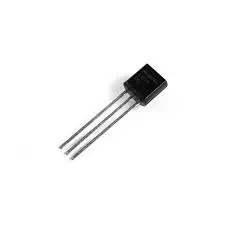Temperature Sensor LM35
The LM35 Temperature Sensor is a high-precision integrated-circuit temperature sensor designed for accurate temperature measurements. It provides a voltage output that is directly proportional to temperature in degrees Celsius. The LM35 is highly valued for its ease of use, cost-effectiveness, and excellent linearity, with a typical accuracy of ±¼°C at room temperature and ±¾°C over a wide temperature range from -55°C to 150°C.
Features:
Centigrade Calibration: The LM35 is calibrated in Celsius, making it ideal for applications where temperature needs to be directly measured in degrees Celsius.
Cost-Effective Wafer-Level Calibration: It’s affordable due to its calibration at the wafer level.
Linear Scale Factor: The sensor has a linear output of 10 mV per degree Celsius, making temperature readings straightforward to interpret.
Low Self-Heating: The LM35 generates minimal self-heating (just 0.08°C in still air), which ensures accuracy.
No External Calibration Needed: The LM35 is pre-calibrated, so it doesn't require additional calibration.
Single Power Supply Compatibility: It operates with a single power supply, adding versatility to its use.
Applications:
Climate Control Systems: Used in HVAC systems to regulate indoor temperatures.
Industrial Automation: Helps monitor machinery temperature, preventing overheating.
Weather Stations: Measures temperature in meteorological stations.
Medical Devices: Found in incubators and fever monitoring systems.
Home Appliances: Ensures proper temperature regulation in appliances like refrigerators and ovens.
Environmental Monitoring: Measures temperature changes in ecosystems.
Automotive: Monitors engine temperatures in vehicles.
Energy Efficiency: Helps regulate systems in energy-efficient buildings.
Food Processing: Ensures proper temperature during food processing.
Scientific Research: Used in laboratories for temperature-sensitive experiments.
Agriculture: Applied in greenhouse temperature monitoring.
Code for Arduino Integration:
#define sensorPin A0 void setup() { // Initialize serial communication at 9600 baud rate Serial.begin(9600); } void loop() { // Read the analog voltage from the LM35 sensor int rawValue = analogRead(sensorPin); // Convert raw reading to voltage (0-5V) float voltage = (rawValue / 1023.0) * 5.0; // Convert voltage to temperature in Celsius float temperatureC = (voltage - 0.5) * 100.0; // Print temperature in Celsius Serial.print("Temperature: "); Serial.print(temperatureC); Serial.print("\xC2\xB0C | "); // Convert Celsius to Fahrenheit float temperatureF = (temperatureC * 9.0 / 5.0) + 32.0; Serial.print(temperatureF); Serial.print("\xC2\xB0F"); // Print a newline for better readability Serial.println(); // Wait for a second before the next reading delay(1000); }
Circuit:
Connect the LM35's VCC pin to the 5V pin of the Arduino.
Connect the OUT pin to the analog pin A0.
Connect the GND pin to the ground.
Technical Details:
Operational Voltage: 4 – 30V
Output Voltage: -1V to 6V
Output Current: 10mA
Operating Temperature: -55°C to 150°C
Accuracy: ±0.5°C at 25°C
Comparisons with NTC Thermistors:
LM35: Provides direct linear voltage output, is pre-calibrated, and requires no further calibration. Ideal for precise temperature measurements in Celsius.
NTC Thermistors: Have non-linear characteristics, requiring calibration. While they are often cheaper, they don’t provide a direct output like the LM35 and are less straightforward to use in temperature measurements.
